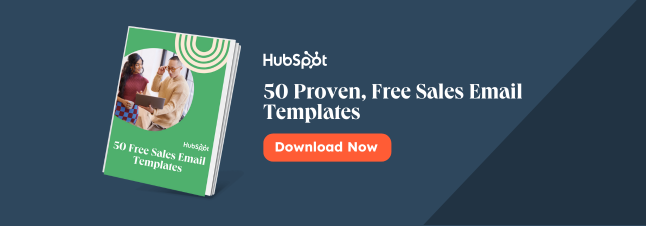What's every salesperson's biggest fear? It's not missing quota or an understocked pipeline -- it's silence from a prospect. A silent prospect leaves deals in indefinite limbo. You can't mark the sale as closed-won, but it's human nature to hope that maybe it'll close. You're stuck.

Silence isn't the only thing salespeople don’t love hearing, of course. “Maybe” comes to mind. When a prospect tells you they’ve gone with a competitor or decided to delay a purchase decision, you can move on, but “maybe” creates the same uncertainty as silence.
Silence, or a "maybe" followed by silence, could mean anything.
- Did you lose the deal?
- Is your prospect avoiding your email or have they just not read it yet? (If you don’t ever want to wonder if a prospect’s opened your email again, HubSpot Sales will take the guesswork out of the equation.)
- Did they go on vacation and forget to set an out-of-office reply?
- Is your contact writing back to you at this very moment? (Probably not.)
Enter the breakup email.
Breakup emails are designed to provoke a response from a prospect whom you haven’t heard from in a while. According to Katharine Derum, senior sales manager at HubSpot, her team sees a 33% response rate to their breakup emails.
These emails enable you to close the communication loop, either confirming a prospect won’t be moving forward or that they’re still interested, but have just been busy. When crafting a breakup email, keep the following things in mind.
7 Breakup Email Templates to Close the Loop on Deals
1. Continue to emphasize that you're here to help.
Prospects have no incentive to speak with a sales rep who’s only interested in the deal for quota’s sake. Reinforce that you’re reaching out for a reason -- to help their business.
Hi [Prospect name],
Haven’t heard from you in a while.
We last spoke about your difficulties with [pain point], and how [offering] could help [achieve specific goal] over [specific timeframe].
Are you still interested in continuing our discussion? If not, please let me know so I can stop reaching out.
Best,
[Your name]

This email is all about the prospect. You’re reaching out because when you last connected, it seemed like your service could be of use to your prospect’s business. Are they still interested in improving their bottom line? Probably.
2. Keep it simple and short.
It’s a safe assumption that your prospect is busy. You don’t need a flowery introduction or build-up in this follow-up email; just get straight to the point.
Hi [Prospect name],
Apologies if my level of persistence has become annoying.
Are you still interested in speaking about your [pain point], specifically in areas of X and Y?
If not, please let me know so I can stop reaching out.
Best,
[Your name]

Being direct puts the deal in your prospect’s hands. You’re still here if your prospect needs you, but you don’t want to be annoying. If the deal is closed-lost, it’s time to professionally wrap the relationship and move on.
3. Close the loop.
Blair Enns of Win Without Pitching calls the following template “the magic email. This template differs from the previous two because you’re effectively taking the ball back into your court.
Hi [Prospect name],
I haven’t heard back from you, so I’m going to assume you’ve gone in a different direction or your priorities have changed.
Let me know if we can be of assistance in the future.
Best,
[Your name]

By removing all emotion from the email and proactively assuming the deal is lost, Enns says, you trigger either relief or want in your prospect.
If they’ve closed with somebody else, your email gives them an out -- you’re assuming things didn’t work out, and your prospect can write back a one-sentence reply affirming that’s the case.
If, however, your prospect is still interested but has just been slow to respond, the idea that you’ve moved on will create a sense of urgency in your prospect. If they still want this deal to happen, they’d better get moving.
4. Add value before walking away.
Hello [Prospect name],
I've reached out a few times to see if it makes sense to connect regarding [business goal]. Since I haven't heard back, I'll assume the timing isn't right.
In the meantime, here are some resources that serve as a starting point for professionals dealing with [business challenge].
- Resource 1
- Resource 2
- Resource 3
If in the future it ever makes sense to reconnect, you can book time on my calendar here. I'm always here to help.
Best,
[Your name]

This template packs a one-two punch: It's written as if the relationship is already over, yet still provides value and an easy way to reconnect with the salesperson should the prospect's interest be stoked.
The matter-of-fact tone incites a sense of urgency in prospects who weren't ready to say goodbye. Providing additional resources and the option to get back in touch on their timeline will create a positive impression on prospects -- goodwill that might not reap any immediate benefits but will only help your brand.
5. Send in your CEO.
Prospects might go dark on you -- a salesperson -- but they're less likely to do so with the CEO of your company. If you need closure once and for all, draft an email as if you were your company's CEO.
Discuss this approach with them, explaining you need a little help moving the deal forward. Ask them to send your already drafted email from their alias and to forward any response your way.
Hello [Prospect name],
My name is X and I'm the CEO of [Company name]. [Sales rep name] said you recently had a demo of our product, and I wanted to personally reach out to see how you think it went.
Your business is important to us, and I'd like to help you in any way I can.
Thanks,
[CEO name]

By having them pick up at your last touch point with the prospect, you've effectively erased their lack of communication since the demo.
The email is not meant to guilt-trip your prospect, but simply to reengage them in conversation. Enlist your top executives as help and give your silent prospect one more chance.
6. Start a new follow-up cycle.
When a prospect goes silent, it doesn't always mean that's the end -- it simply means it's the end for now. Communicate you'll check back in six months -- and continue to touch base at a regular cadence.
Hello [Prospect name],
I haven't heard from you in a while, so I'll assume [Product/service] isn't a priority at the moment. I completely understand and don't want to take up any more of your time.
I'll check back in six months or so to see if our goals are more aligned.
Regards,
[Your name]

By keeping things friendly and open -- and not getting desperate -- you'll save the relationship and keep future opportunities alive. Then, when that time comes, follow up by starting a new thread on a different topic -- don't just come back into their inbox pestering them again. Send them a neutral message about something of interest to them that might start a conversation organically, such as:
“Hi [Prospect name]! How've you been? I saw a press announcement your company will be at Trade Show X this summer. Will you be attending? Let me know if you'd like to grab a coffee if we'll both be there.”
7. Ask them a question.
Along the same lines as starting a new thread, asking prospects an innocuous question might restart communications if they've let their replies lapse. It can be specifically related to a product or deal you discussed, or it can be something about their work or industry that might re-open lines of communication:
Hi [Prospect name],
I hope you're having a great week so far! I saw that [Prospect's company] launched a new product this week, congratulations! How was that experience for your team?
Hope all is well!
Cheers,
[Your name]

Breakup emails serve as a valuable way to jolt a relationship back into motion, or put it to rest for good. Whatever your prospect says, you can move forward knowing exactly where you stand.
Need fresh sales email templates or prospecting email templates? We've got you covered. And these sales email templates to use when prospects aren't ready to buy might be just the ticket for interested prospects not yet ready to sign the papers.
![Download Now: 25 Sales Email Templates [Free Access]](https://no-cache.hubspot.com/cta/default/53/be67aa79-8dbe-4938-8256-fdf195247a9c.png)



.jpg)






